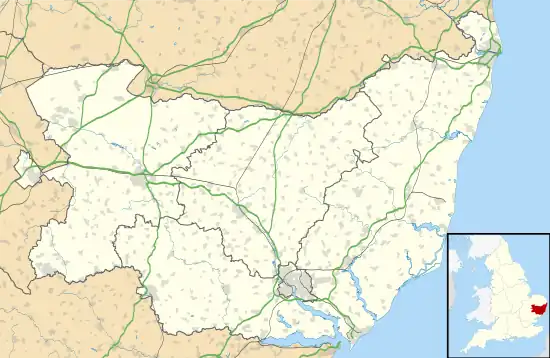| St Mary's Church, Bungay | |
|---|---|
 St Mary's Church, Bungay, from the west | |
 St Mary's Church, Bungay Location from Suffolk | |
| 52°27′20″N 1°26′16″E / 52.4556°N 1.4379°E | |
| OS grid reference | TM 337 898 |
| Location | Bungay, Suffolk |
| Country | England |
| Denomination | Anglican |
| Website | Churches Conservation Trust |
| Architecture | |
| Functional status | Redundant |
| Heritage designation | Grade I |
| Designated | 9 May 1949 |
| Architectural type | Church |
| Style | Perpendicular Gothic |
| Specifications | |
| Materials | Flint and stone |
St Mary's Church is a redundant Anglican church in the town of Bungay, Suffolk, England. The church and the ruins of the adjacent priory are recorded in the National Heritage List for England as a designated Grade I listed building,[1] and are under the care of the Churches Conservation Trust.[2] The church stands in the centre of the town on St Mary's Street, the A144 road.[2][3]
History
St Mary's was built as the church to a Benedictine priory. This was established in the late 12th century, but the main part of the present church dates from the 14th–15th century. The Domesday Survey records a church dedicated to the Holy Cross in the town, and it is thought that St Mary's stands on the site of an earlier Saxon church. The priory was closed in 1536 as a result of the dissolution of the monasteries, St Mary's became a parish church, and a grammar school was established in one of the priory's chapels.[4] In 1577 the church was struck by lightning, and this event led to the "Legend of the Black Dog".[5][6]
The church was damaged in a great fire in the town in 1688. The roof of the south aisle and some of the fittings, including benches and possibly the pulpit, were burnt, but the roof of the nave was not damaged.[7] The south aisle was re-roofed in 1699, and the church re-opened in 1701.[1] In 1879 the tower was repaired, and the rest of the church was restored, at a cost of £3,000 (equivalent to £320,000 in 2021).[8][9] During the 20th century the size of the congregation declined and the church was declared redundant.[4] Its benefice has been united with that of Holy Trinity Church.[10] A society, The Friends of St Mary's, cleans the church and organises concerts and other events in the church.[4]
Architecture
Exterior
The church is constructed in flint and stone in Perpendicular style. Its plan consists of a nave with a clerestory, north and south aisles, and a tower.[9] The tower stands at the west end of the south aisle,[7] and it is surmounted by four tall crocketted pinnacles. There is no chancel.[9] The tower is 110 feet (33.5 m) high.[2] There are ruined remains of the priory in the churchyard to the east of the church.[2]
Interior
The arcades are supported on five columns consisting of clustered shafts.[7] The west window is particularly large and has complicated tracery in its upper part. The bosses in the roof are carved with a variety of objects, including angels, a lion, two-headed eagles, and a bat. Near the entrance to the church is a dole cupboard, carved with a rat. Bread was placed in the dole cupboard to be given to the poor. Part of the church has been converted into a War Memorial Chapel. This contains a 17th-century Flemish panel depicting the Resurrection that was given to the church by the author H. Rider Haggard.[2] The two-manual organ was made by E. W. Norman, and was moved to the church from Rose Hall, Bungay. It was rebuilt in 1961 by Walker.[11] There is a ring of eight bells, all cast in 1820 by Thomas Mears II of the Whitechapel Bell Foundry.[12]
Legend of the Black Dog
The church was struck by lightning on Sunday 4 August 1577. During the thunderstorm an apparition appeared, consisting of a black Hell Hound which dashed around the church, attacking members of the congregation. It then suddenly disappeared and re-appeared in Holy Trinity Church, Blythburgh 12 miles (19 km) away, injuring members of the congregation there. The dog has been associated with Black Shuck, a dog haunting the coasts of Norfolk, Essex and Suffolk. An image of the Black Dog has been incorporated in the coat of arms of Bungay and has been used in the titles of various enterprises associated with Bungay.[6]
See also
References
- 1 2 Historic England, "Church of St Mary (including ruins of Benedictine convent), Bungay (1216850)", National Heritage List for England, retrieved 9 February 2014
- 1 2 3 4 5 St Mary's Church, Bungay, Suffolk, Churches Conservation Trust, retrieved 9 December 2016
- ↑ Bungay, Streetmap, retrieved 7 March 2011
- 1 2 3 Churches in Bungay: St Mary's Church, Sanderling Internet, retrieved 7 March 2011
- ↑ "Bungay: History of Bungay", EDP24, Archant Regional, 13 April 2010, retrieved 7 March 2011
- 1 2 History of the Black Dog of Bungay, Sanderling Internet, retrieved 7 March 2011
- 1 2 3 Suckling, Alfred (1846), "Bungay", The History and Antiquities of the County of Suffolk, Ipswich: WS Crowell, vol. 1, pp. 119–161, retrieved 29 June 2020 – via British History Online
- ↑ UK Retail Price Index inflation figures are based on data from Clark, Gregory (2017), "The Annual RPI and Average Earnings for Britain, 1209 to Present (New Series)", MeasuringWorth, retrieved 11 June 2022
- 1 2 3 "Suffolk — Bungay", Kelly's Directory for Cambridgeshire, Norfolk & Suffolk, 1883, Kelly's Directory, pp. 824–828, retrieved 7 March 2011
- ↑ Bungay, Holy Trinity with St Mary, Bungay, Church of England, retrieved 7 March 2011
- ↑ "NPOR [N00899]", National Pipe Organ Register, British Institute of Organ Studies, retrieved 30 June 2020
- ↑ Bungay, S Mary, Dove's Guide for Church Bell Ringers, retrieved 7 March 2011